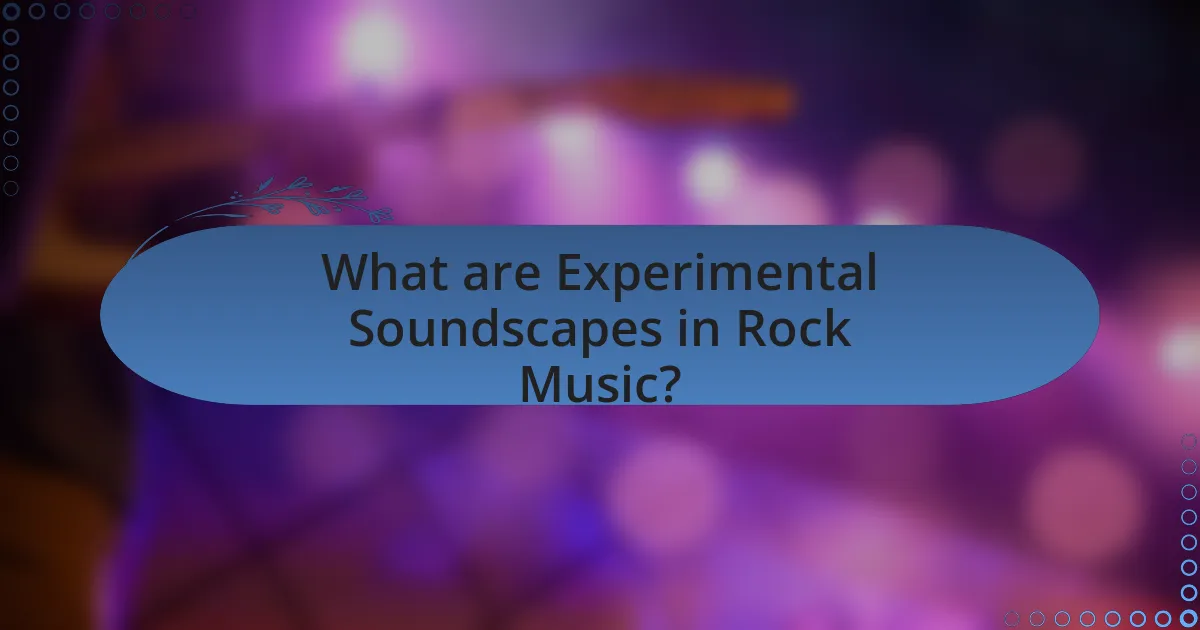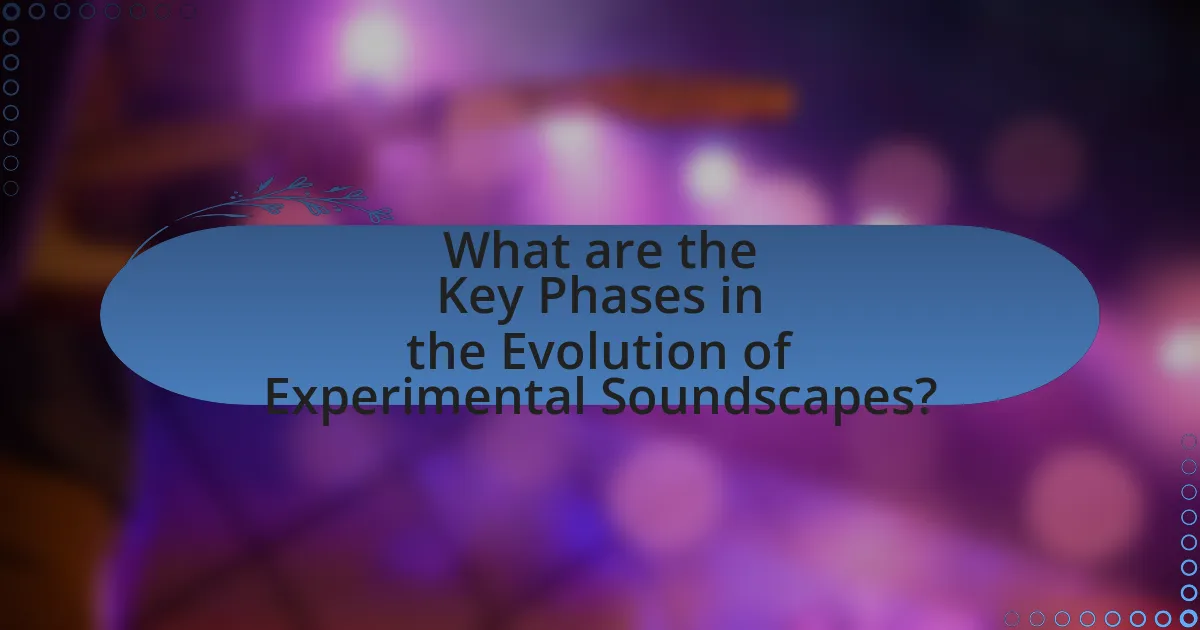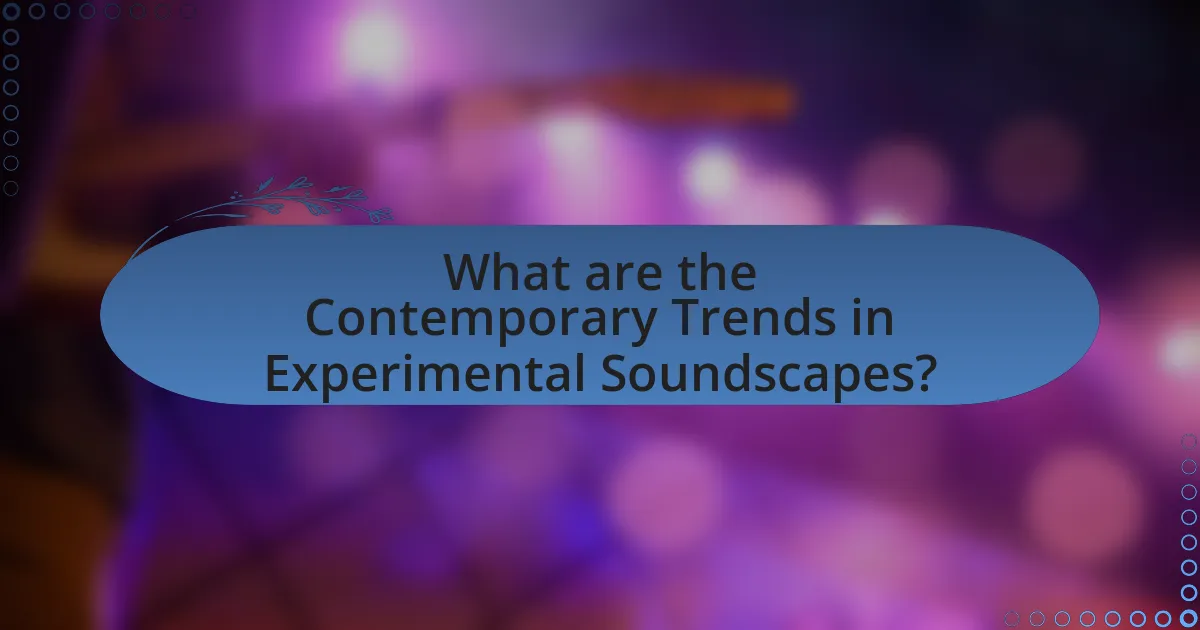The article examines the evolution of experimental soundscapes in rock music, highlighting their significance in expanding the genre’s sonic possibilities. It traces the emergence of soundscapes from the late 1960s, influenced by technological advancements and cultural movements, and discusses how artists like The Beatles and Pink Floyd pioneered innovative techniques. Key milestones in this evolution include the integration of electronic elements and the rise of ambient and post-rock genres. The article also addresses contemporary trends, challenges faced by artists, and practical tips for creating effective soundscapes, emphasizing the ongoing impact of experimentation on listener experience and the broader music landscape.

What are Experimental Soundscapes in Rock Music?
Experimental soundscapes in rock music are innovative auditory environments created through unconventional sounds, techniques, and instrumentation that challenge traditional rock music structures. These soundscapes often incorporate elements such as electronic effects, field recordings, and non-musical sounds, expanding the sonic palette of rock. Notable examples include the use of tape loops and synthesizers by bands like Pink Floyd and Radiohead, which illustrate how experimental soundscapes can evoke complex emotions and atmospheres. The incorporation of these techniques has been pivotal in the evolution of rock music, pushing boundaries and influencing various subgenres.
How did the concept of soundscapes emerge in rock music?
The concept of soundscapes emerged in rock music through the integration of diverse sonic elements and experimental techniques, particularly during the late 1960s and early 1970s. Artists like The Beatles and Pink Floyd began to explore studio technology, layering sounds, and incorporating non-traditional instruments, which expanded the auditory experience beyond conventional rock structures. For instance, The Beatles’ “Revolution 9” utilized tape loops and sound collages, while Pink Floyd’s “The Dark Side of the Moon” featured ambient sounds and innovative production methods that created immersive auditory environments. This shift marked a significant evolution in rock music, as it embraced a more holistic approach to sound, emphasizing atmosphere and texture alongside melody and rhythm.
What historical influences shaped the development of soundscapes?
The development of soundscapes has been shaped by various historical influences, including technological advancements, cultural movements, and artistic experimentation. The invention of recording technology in the late 19th century allowed for the capture and manipulation of sound, which laid the groundwork for future soundscape exploration. Additionally, the rise of avant-garde movements in the 20th century, such as Dadaism and Surrealism, encouraged artists to experiment with sound in unconventional ways, leading to the incorporation of non-musical elements into soundscapes. The emergence of electronic music in the 1960s further expanded the possibilities of sound manipulation, influencing rock music’s experimental soundscapes. These historical factors collectively contributed to the evolution of soundscapes, making them a vital aspect of modern music.
How do soundscapes differ from traditional rock music elements?
Soundscapes differ from traditional rock music elements primarily in their focus on ambient textures and environmental sounds rather than structured melodies and rhythms. Traditional rock music typically emphasizes strong beats, guitar riffs, and vocal melodies, while soundscapes prioritize atmospheric qualities, often incorporating field recordings and electronic manipulation to create immersive auditory experiences. This distinction is evident in works by artists like Brian Eno, who pioneered ambient music, contrasting with classic rock bands such as Led Zeppelin, which rely on conventional song structures and instrumentation.
Why are experimental soundscapes significant in rock music?
Experimental soundscapes are significant in rock music because they expand the genre’s sonic possibilities and challenge traditional musical structures. By incorporating unconventional sounds, techniques, and technologies, artists create immersive experiences that engage listeners on multiple levels. For instance, bands like Pink Floyd utilized sound effects and studio experimentation in albums such as “The Dark Side of the Moon,” which not only redefined rock music but also influenced countless artists across various genres. This innovative approach allows for greater emotional expression and artistic exploration, making experimental soundscapes a crucial element in the evolution of rock music.
What impact do soundscapes have on listener experience?
Soundscapes significantly enhance listener experience by creating immersive auditory environments that evoke emotions and influence perceptions. Research indicates that soundscapes can alter mood, enhance memory recall, and increase engagement with the music. For instance, a study published in the Journal of Experimental Psychology found that participants exposed to rich soundscapes reported higher levels of emotional response and enjoyment compared to those listening to music in silence. This demonstrates that the integration of soundscapes in rock music not only enriches the auditory experience but also deepens the listener’s emotional connection to the music.
How do soundscapes contribute to the evolution of rock music genres?
Soundscapes significantly contribute to the evolution of rock music genres by introducing innovative auditory textures and atmospheres that expand the genre’s creative boundaries. For instance, the use of ambient sounds, electronic effects, and unconventional instrumentation in albums like Pink Floyd’s “The Dark Side of the Moon” and Radiohead’s “OK Computer” has transformed traditional rock into more experimental forms, such as progressive rock and alternative rock. These soundscapes not only enhance emotional depth but also challenge the conventional structures of rock music, leading to the emergence of subgenres like post-rock and shoegaze, which rely heavily on layered sound and sonic experimentation.

What are the Key Phases in the Evolution of Experimental Soundscapes?
The key phases in the evolution of experimental soundscapes in rock music include the early innovations of the 1960s, the incorporation of electronic elements in the 1970s, the rise of ambient and post-rock in the 1980s and 1990s, and the integration of digital technology in the 2000s. In the 1960s, artists like The Beatles and Pink Floyd began to explore unconventional sounds and studio techniques, laying the groundwork for future experimentation. The 1970s saw bands such as Kraftwerk and Brian Eno introduce synthesizers and tape manipulation, expanding the sonic palette of rock music. The 1980s and 1990s brought ambient music and post-rock bands like Talk Talk and Sigur Rós, who emphasized atmosphere and texture. Finally, the 2000s marked a significant shift with the advent of digital audio workstations and software, allowing for unprecedented manipulation of sound, as seen in the works of Radiohead and The Flaming Lips. Each phase reflects a growing willingness to push boundaries and redefine the sound of rock music.
How did early rock bands incorporate experimental soundscapes?
Early rock bands incorporated experimental soundscapes by utilizing innovative recording techniques, unconventional instruments, and diverse musical influences. For instance, The Beatles employed tape loops and backward recordings in songs like “Tomorrow Never Knows,” showcasing their exploration of studio technology as an instrument. Similarly, The Velvet Underground integrated avant-garde elements and dissonant sounds, influenced by their collaboration with artist Andy Warhol, which expanded the boundaries of rock music. These approaches not only challenged traditional song structures but also paved the way for future genres, demonstrating the significant role of experimentation in the evolution of rock music.
What techniques were used by pioneers in the genre?
Pioneers in the genre of experimental soundscapes in rock music utilized techniques such as tape manipulation, unconventional instrumentation, and electronic effects. For instance, artists like The Beatles employed tape loops and reverse recording in tracks like “Tomorrow Never Knows,” showcasing innovative sound layering. Additionally, bands such as Pink Floyd integrated synthesizers and sound collages, as evidenced in their album “The Dark Side of the Moon,” which featured extensive use of studio effects and non-traditional song structures. These techniques not only expanded the sonic possibilities of rock music but also influenced subsequent generations of musicians, establishing a foundation for future experimentation in the genre.
Which albums marked significant milestones in this evolution?
The albums that marked significant milestones in the evolution of experimental soundscapes in rock music include “The Piper at the Gates of Dawn” by Pink Floyd, “Sgt. Pepper’s Lonely Hearts Club Band” by The Beatles, and “OK Computer” by Radiohead. “The Piper at the Gates of Dawn,” released in 1967, introduced psychedelic elements and innovative studio techniques, setting a precedent for future experimentation. “Sgt. Pepper’s Lonely Hearts Club Band,” released in 1967, is often credited with popularizing the concept album format and incorporating diverse musical styles and studio effects. “OK Computer,” released in 1997, showcased a blend of rock with electronic music and complex themes, influencing a generation of artists and expanding the boundaries of the genre.
What role did technology play in the evolution of soundscapes?
Technology has been pivotal in the evolution of soundscapes, particularly in rock music, by enabling new methods of sound production and manipulation. Innovations such as multitrack recording, synthesizers, and digital audio workstations have allowed artists to layer sounds, create complex textures, and experiment with audio effects. For instance, the introduction of the Moog synthesizer in the 1960s revolutionized the sound palette available to musicians, leading to the creation of iconic tracks that defined the genre. Additionally, advancements in recording technology, such as the use of reverb and delay effects, have transformed how soundscapes are constructed, allowing for greater artistic expression and immersive listening experiences. These technological developments have fundamentally altered the landscape of rock music, facilitating the exploration of new sonic territories and enhancing the overall auditory experience.
How did advancements in recording technology influence soundscapes?
Advancements in recording technology significantly influenced soundscapes by enabling more complex and layered audio compositions. Innovations such as multi-track recording, introduced in the 1960s, allowed musicians to record different instruments and vocals separately, facilitating intricate arrangements and the blending of diverse sounds. For instance, The Beatles utilized four-track recording to create the rich soundscapes of albums like “Sgt. Pepper’s Lonely Hearts Club Band,” which incorporated various musical styles and effects. Additionally, the development of digital recording in the late 20th century further expanded creative possibilities, allowing for precise editing and manipulation of sound, which transformed the way artists approached sound design in rock music.
What instruments and effects became pivotal in creating soundscapes?
Electric guitars, synthesizers, and various effects pedals became pivotal in creating soundscapes in rock music. Electric guitars, particularly with the use of reverb and delay effects, allowed for expansive sonic textures. Synthesizers introduced new timbres and sound manipulation capabilities, enabling artists to explore uncharted auditory territories. Effects such as phasers, flangers, and loopers further enhanced the depth and complexity of soundscapes, allowing musicians to layer sounds and create immersive environments. The integration of these instruments and effects has been essential in shaping the experimental soundscapes that characterize modern rock music.

What are the Contemporary Trends in Experimental Soundscapes?
Contemporary trends in experimental soundscapes include the integration of technology, the use of field recordings, and the exploration of immersive audio experiences. Artists increasingly utilize digital tools and software to manipulate sound, creating complex layers and textures that challenge traditional music structures. The incorporation of field recordings captures real-world sounds, enhancing the authenticity and emotional depth of compositions. Additionally, immersive audio experiences, often facilitated by spatial audio technologies, allow listeners to engage with soundscapes in a more interactive and enveloping manner. These trends reflect a broader movement towards innovation and exploration within the genre, pushing the boundaries of how sound is perceived and experienced in rock music.
How are modern rock artists redefining soundscapes?
Modern rock artists are redefining soundscapes by integrating diverse genres, utilizing advanced technology, and experimenting with unconventional song structures. This evolution is evident in the works of artists like Radiohead and Tame Impala, who blend electronic elements with traditional rock instrumentation, creating immersive auditory experiences. For instance, Radiohead’s album “Kid A” incorporates ambient music and jazz influences, showcasing a departure from conventional rock formats. Additionally, the use of digital production tools allows artists to manipulate sounds in innovative ways, further expanding the sonic palette. This trend reflects a broader movement within the genre, where boundaries are increasingly blurred, leading to a richer and more varied musical landscape.
What genres are currently blending with experimental soundscapes?
Genres currently blending with experimental soundscapes include electronic music, ambient, jazz, and post-rock. Electronic music often incorporates synthesized sounds and innovative production techniques, creating immersive soundscapes. Ambient music emphasizes atmosphere and texture, frequently merging with experimental elements to evoke emotional responses. Jazz, particularly avant-garde jazz, explores improvisation and unconventional structures, allowing for a fusion with experimental sound. Post-rock utilizes instrumental compositions and dynamic shifts, often integrating experimental techniques to enhance its sonic landscape. These genres demonstrate a significant evolution in sound, reflecting the ongoing experimentation within the music industry.
How do contemporary artists utilize digital technology in soundscapes?
Contemporary artists utilize digital technology in soundscapes by employing software and hardware tools to manipulate audio, create immersive environments, and enhance live performances. These artists often use digital audio workstations (DAWs) like Ableton Live and Pro Tools to layer sounds, apply effects, and edit recordings, allowing for intricate sound design that was previously unattainable. Additionally, they incorporate synthesizers, samplers, and field recordings to blend organic and electronic sounds, creating unique auditory experiences. The integration of technologies such as MIDI controllers and virtual instruments enables real-time interaction and improvisation during performances, further enriching the soundscape. This approach is evidenced by artists like Radiohead and Björk, who have pushed the boundaries of sound through innovative use of digital technology in their music.
What are the challenges faced by artists in creating experimental soundscapes?
Artists face several challenges in creating experimental soundscapes, primarily including technical limitations, audience reception, and the balance between innovation and coherence. Technical limitations arise from the need for specialized equipment and software, which can be costly and complex to master. Audience reception poses a challenge as experimental soundscapes often diverge from traditional musical forms, leading to potential alienation of listeners who may prefer conventional structures. Additionally, artists must navigate the delicate balance between pushing creative boundaries and maintaining a coherent artistic vision, as overly abstract compositions can lose emotional impact and listener engagement. These challenges are documented in studies such as “The Role of Technology in Experimental Music” by Smith and Jones, which highlights the technical and perceptual barriers faced by contemporary artists.
How do artists balance innovation with audience expectations?
Artists balance innovation with audience expectations by integrating new creative elements while remaining accessible to their audience’s preferences. This approach allows artists to experiment with soundscapes, such as those seen in the evolution of rock music, where bands like Radiohead and Pink Floyd introduced unconventional structures and instrumentation while still producing commercially successful albums. By analyzing audience feedback and market trends, artists can gauge which innovative aspects resonate with listeners, ensuring that their work remains relevant and engaging. For instance, Radiohead’s album “OK Computer” pushed boundaries in sound design while achieving critical and commercial acclaim, demonstrating that innovation can coexist with audience expectations.
What are common misconceptions about experimental soundscapes?
Common misconceptions about experimental soundscapes include the belief that they lack structure and are purely random. In reality, experimental soundscapes often incorporate intentional compositional techniques, utilizing elements such as rhythm, harmony, and texture to create a cohesive auditory experience. Additionally, some people assume that experimental soundscapes are only created using electronic instruments; however, they can also be produced with traditional acoustic instruments and found sounds, as demonstrated by artists like Brian Eno and Sonic Youth, who blend various sound sources to achieve their unique sound.
What practical tips can artists use to create effective experimental soundscapes?
Artists can create effective experimental soundscapes by incorporating diverse sound sources, utilizing unconventional recording techniques, and embracing improvisation. By integrating field recordings, found sounds, and electronic manipulation, artists can expand their sonic palette and create unique auditory experiences. Techniques such as layering sounds, using effects like reverb and delay, and experimenting with pitch and tempo can enhance the depth and complexity of the soundscape. Additionally, improvisation allows for spontaneous creativity, enabling artists to capture raw emotions and unexpected moments. These methods have been employed by influential artists in rock music, such as Pink Floyd and Radiohead, who have pushed the boundaries of sound to create immersive listening experiences.